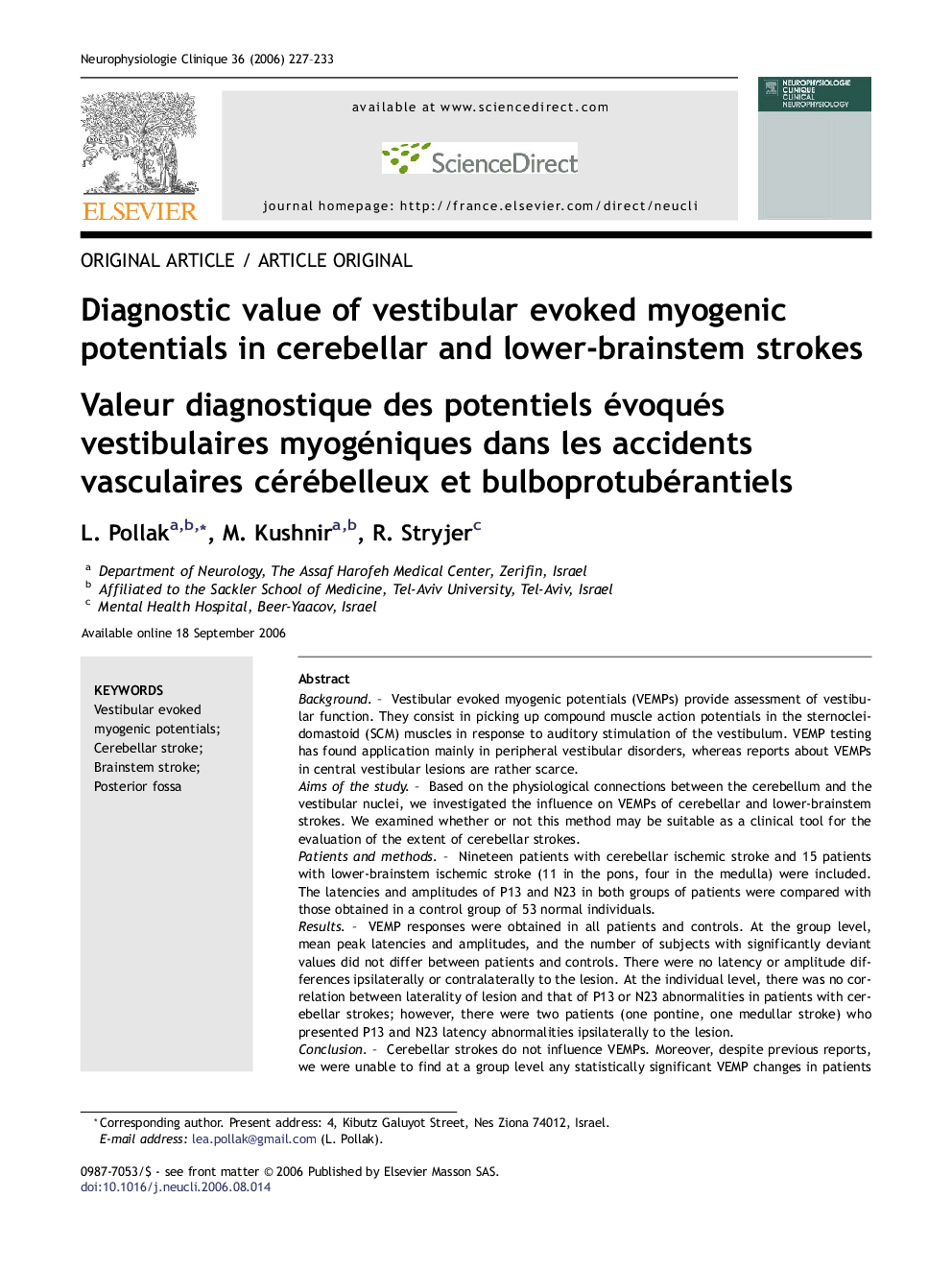| Article ID | Journal | Published Year | Pages | File Type |
|---|---|---|---|---|
| 3083329 | Neurophysiologie Clinique/Clinical Neurophysiology | 2006 | 7 Pages |
BackgroundVestibular evoked myogenic potentials (VEMPs) provide assessment of vestibular function. They consist in picking up compound muscle action potentials in the sternocleidomastoid (SCM) muscles in response to auditory stimulation of the vestibulum. VEMP testing has found application mainly in peripheral vestibular disorders, whereas reports about VEMPs in central vestibular lesions are rather scarce.Aims of the studyBased on the physiological connections between the cerebellum and the vestibular nuclei, we investigated the influence on VEMPs of cerebellar and lower-brainstem strokes. We examined whether or not this method may be suitable as a clinical tool for the evaluation of the extent of cerebellar strokes.Patients and methodsNineteen patients with cerebellar ischemic stroke and 15 patients with lower-brainstem ischemic stroke (11 in the pons, four in the medulla) were included. The latencies and amplitudes of P13 and N23 in both groups of patients were compared with those obtained in a control group of 53 normal individuals.ResultsVEMP responses were obtained in all patients and controls. At the group level, mean peak latencies and amplitudes, and the number of subjects with significantly deviant values did not differ between patients and controls. There were no latency or amplitude differences ipsilaterally or contralaterally to the lesion. At the individual level, there was no correlation between laterality of lesion and that of P13 or N23 abnormalities in patients with cerebellar strokes; however, there were two patients (one pontine, one medullar stroke) who presented P13 and N23 latency abnormalities ipsilaterally to the lesion.ConclusionCerebellar strokes do not influence VEMPs. Moreover, despite previous reports, we were unable to find at a group level any statistically significant VEMP changes in patients with lower-brainstem strokes as compared with controls. Therefore, VEMPs do not appear a suitable tool for assessment of brainstem integrity in patients with posterior fossa strokes. However, they could constitute a sensitive method for documentation of involvement of the central vestibular pathways in patients with brainstem stroke.
RésuméIntroductionLes potentiels évoqués vestibulaires myogènes (PEVM) correspondent à des réponses des muscles sternocléidomastoïdiens induites par des stimulations auditives du vestibule. Ils testent la fonction vestibulaire. Leurs applications cliniques connues concernent les dysfonctionnements vestibulaires périphériques ; on connaît peu leurs applications possibles dans les désordres vestibulaires d'origine centrale.Buts de l'étudeVu l'existence d'une connectivité entre le cervelet et les noyaux vestibulaires, nous examinons l'influence sur les PEVM d'accidents vasculaires cérébelleux et de la région bulboprotubérantielle. Nous posons la question de savoir si cette méthode constitue un outil d'investigation valable dans le cadre des accidents vasculaires cérébelleux.Patients et méthodesNous avons examiné 19 et 15 patients ayant présenté des accidents vasculaires respectivement cérébelleux et bulboprotubérantiels (11 accidents protubérantiels, quatre accidents bulbaires). Les temps de latence et les amplitudes des composantes P13 et N23 des PEVM obtenus chez ces patients ont été comparés à ceux obtenus dans un groupe témoin de 53 sujets normaux.RésultatsDes PEVM reproductibles ont été obtenus chez tous les patients et les contrôles. Au niveau des groupes, les temps de latence et amplitude moyens et le nombre de sujets présentant des valeurs s'écartant significativement de la moyenne ne diffèrent pas chez les patients et les contrôles et on ne trouve aucune différence d'amplitude ou de temps de latence ipsi- ou controlatéralement par rapport à la lésion. Au niveau individuel, il n'y a aucune corrélation entre le côté de la lésion et la latéralité des anomalies de la P13 et de la N23 dans le groupe des AVC cérébelleux. En revanche, deux patients présentant des AVC bulbaire et protubérantiel ont présenté des anomalies de temps de latence des ondes P13 et N23 ipsilatéralement par rapport à la lésion.ConclusionsLes accidents vasculaires cérébelleux n'influencent pas les PEVM. De plus, et contrairement à des travaux antérieurs, nous n'avons identifié par rapport au groupe témoin aucune altération significative des PEVM dans le groupe des patients présentant des accidents vasculaires tronculaires inférieurs. Les PEVM ne semblent donc pas constituer un test valable pour l'évaluation de l'intégrité du tronc cérébral dans les accidents vasculaires de la fosse postérieure. Ils pourraient cependant constituer un test valable de recherche d'atteinte des voies vestibulaires centrales dans les AVC du tronc.
